Parts of Yosemite National Park Are Closing Due to Concerns of Melting Snow Triggering Floods

Yosemite National Park was forced to close three campgrounds this week due to a dangerous combination of rising temperatures and melting snow leftover from heavy winter storms draining down from the Sierra Nevada.
The National Park Service announced the closures of both Lower and North Pines Campgrounds, as well Housekeeping Camp on Monday, expecting them to be closed through at least mid-week but most likely for longer. The park said in a statement that it would announce any additional closures two days in advance, and that flooding was anticipated through at least mid-June.
"Do not approach or enter rivers or creeks in Yosemite; they are extremely dangerous," the statement read. "Watch for flooding on roads, especially from 10:00 pm to 8:00 am. Use caution when you encounter water on the road."
Likewise, the flooding and lingering winter weather has contributed to several road closures in the area. According to current conditions posted on the National Park Service's website, Big Oak Flat Road is closed with no access to most of Yosemite via Highway 120 from the west. Likewise, Tioga Road and Glacier Point Road are still closed due to the snow, and will reopen later than usual this summer.
In an update on Monday, Yosemite said that there was not an estimated opening date for Tioga Road.
Related: Popular National Park Lodge Destroyed in Fire
"Snowpack was measured on April 1 as 240 percent of average, the highest ever recorded for this area," the park said in a Facebook post. "In previous years with very heavy snowpack, Tioga Road did not re-open until late June or early July. Much of Yosemite's Wilderness will likely be covered in snow well into summer."
Heavy snowpack is also melting at a slower pace than usual, compounding the park's problems. This has been due to below-average temperatures in early April, followed by extended hot weather in May.
Closures in Yosemite National Park are not the only unintended consequences of historic snowfall on the Sierra Nevada. The flooding has also triggered an apparent gold rush, exacerbated by recent wildfires loosening the soil.
